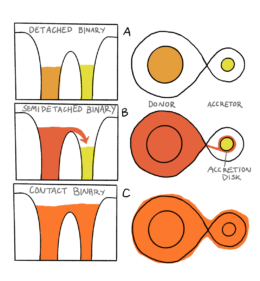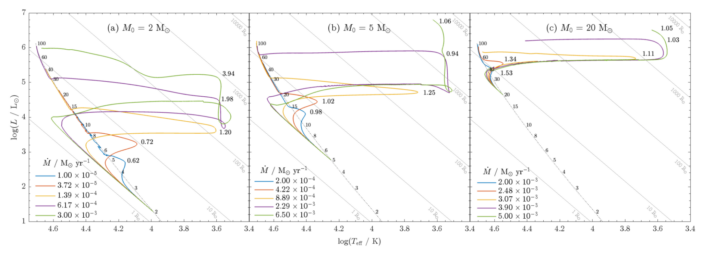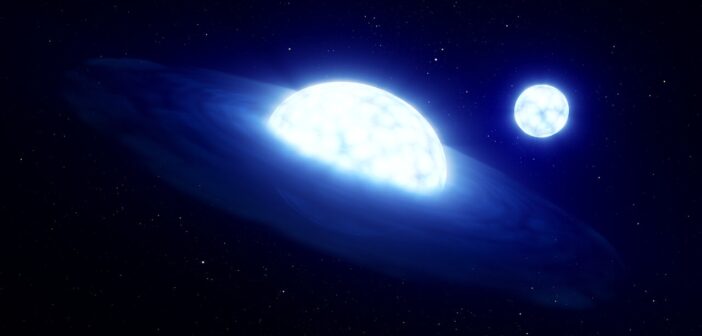Editor’s Note: Astrobites is a graduate-student-run organization that digests astrophysical literature for undergraduate students. As part of the partnership between the AAS and astrobites, we occasionally repost astrobites content here at AAS Nova. We hope you enjoy this post from astrobites; the original can be viewed at astrobites.org.
Title: Expansion of Accreting Main-Sequence Stars During Rapid Mass Transfer
Authors: Mike Y. M. Lau et al.
First Author’s Institution: Heidelberg Institute for Theoretical Studies
Status: Accepted to ApJL
In our universe, most stars live in binaries. These stars live together, orbiting around each other, evolving and influencing each other’s lives. For many stars, this can be a tumultuous relationship with periods of mass transfer, altering the stars’ lives from the typical single-star evolution from a main-sequence star to a red giant to a stellar remnant. Mass transfer allows stars to grow and shrink in mass through their evolution, changing their identities and speeding up or slowing down their evolution. Mass transfer can also cause stars to go supernova.

Figure 1: An Illustration of Roche lobe filling of binary stars in three different scenarios, A, B, and C. The left column shows the gravitational potential wells for each star, while the right column outlines the stars and their Roche lobes (the teardrop shapes around them). In scenario A, the matter of both stars is within each potential well and the stars are detached. In scenario B, the left star has expanded and filled its Roche lobe, causing matter to accrete onto the right star. In scenario C, both stars have filled their Roche lobes and orbit in a contact binary. [Storm Colloms, adapted from Pringle and Wade, Interacting Binary Stars (1985, Cambridge University Press)]
As common as mass transfer is in the lives of stars, there are a lot of unknowns about mass transfer processes. Astronomers make simulations of stars transferring mass to try to understand these unknowns better. Simulating a fully accurate model of these processes requires many computational resources to model the hydrodynamic processes in all dimensions, and so models always make some simplifying assumptions.
One big simplifying assumption is how much of the donor star’s mass can be packed onto the accreting star. Previous models assumed that the accreting star does not change with time when accepting mass from the donor star. However, today’s authors are actually able to investigate how the properties of the accreting star change through the mass-transfer period using a stellar evolution code called Modules for Experiments in Stellar Astrophysics (MESA).
The authors show that how the accretor’s mass and radius respond to mass transfer depends on two timescales: 1) the thermal timescale of the accretor — this is the timescale on which the accretor can radiate away all of its thermal energy, and 2) the timescale of the accretion — this is the rate of mass transfer from the donor to the accretor. The thermal timescale of the accreting star is generally much longer than the mass-transfer timescale, meaning that during mass transfer the accreting star is fed mass much more quickly than it can “swallow” it, or have it thermally cool and settle onto the star. However, the accreting star can store this accreted matter in an envelope around it, stuffing it in its cheeks much like a hamster, as long as this does not spill over the edge of the Roche lobe — hence why the authors coin the name “hamstars” for these stars. This “cheek stuffing” makes the accreting star grow in radius and cool much like a typical main-sequence star becoming a red giant, as shown in Figure 2. As the star accretes more and more and its luminosity increases, its thermal timescale decreases, and it can radiate away the energy of accreting mass and “swallow” the matter faster. The star then shrinks from its expanded radius, having grown several times in mass.

Figure 2: Hertzsprung–Russell diagrams showing the evolution of the accreting star during mass transfer. The three panels show the temperature versus luminosity for accretors of different initial masses, and each track in the panels is a different rate of mass transfer in the simulation. Most of the stars cool at some point in evolution, expanding in radius, before the accreted matter can cool onto the star and it shrinks and heats again, resuming its usual evolution having grown several times in mass. [Lau et al. 2024]
The accretion efficiency determines how much of the mass accreted actually makes it onto the accreting star, versus how much might be lost during mass transfer. While low-mass stars can pack a lot of accreting matter in their hamster cheeks, high-mass stars have a lower limit for how much matter they can chew. These higher-mass accreting stars make up observed populations of X-ray binaries and the progenitors of pairs of black holes and/or neutron stars. Compared to current models, the authors’ prescription for accretion efficiency is in better agreement with the observed population of X-ray binaries and predicts fewer merging black hole binaries that could be observed with gravitational waves, something we could investigate further with more observations.
While today’s article considers the accretor’s response to mass transfer (pinning down the similarities between stars and rodents), it does not account for the accreting star’s spin or mass loss. If a star is spinning fast, it could limit how much the accreting star can expand. Some mass can also be swept away by stellar winds, meaning that not all of the mass lost by one star is accreted onto the other. Future work is needed to incorporate these additional factors before we can look up into the cosmos for a great hamstar hunt!
Original astrobite edited by Lucie Rowland.
About the author, Storm Colloms:
Storm is a postgraduate researcher at the University of Glasgow, Scotland. They work on understanding populations of binary black holes and neutron stars from the gravitational wave signals emitted when they merge, and what that tells us about the lives and deaths of massive stars. Outwith astrophysics they spend their time taking digital and film photos, and making fun doodles of their research.

